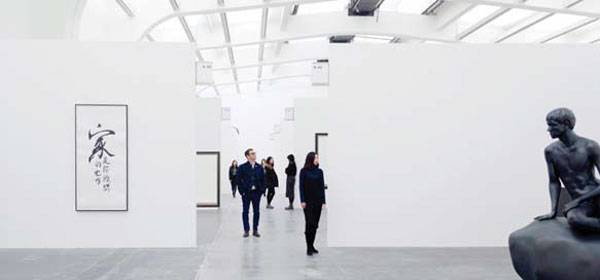Art show that has room for sarcasm
Michael Elmgreen and Ingar Dragset are a Scandinavian artist duo who have gained global acclaims for a series of works that blend architecture, art and design to explore and redefine space and its numerous possibilities of definition and function.
Perhaps their best-known project is Prada Marfa, a permanent installation inaugurated in 2005 in the middle of the West Texas desert in the United States, near the town of Marfa. The display, modeled on an outlet of the famous fashion brand, is surrounded only by the high desert and has neither entrance nor exit. The artists have since exhibited around the world.
In their first exhibition in the Chinese mainland, they continue their practice of structural displacement to merge one familiar space with another. The Well Fair, on display at the Ullens Center for Contemporary Art in Beijing to April 17, transforms the museum's great hall into a fictional art fair.
|
The Well Fair continues the artists' practice of structural displacement and transforms the museum's great hall into a fictional art fair. Provided to China Daily |
They divide the space into rectangular booths and display more than 80 works of theirs from the past two decades in a particular way: in some cases, crated, wrapped, half-installed or leaned against the walls. "It looks as if the fair has either just ended or not yet begun", says Danish artist Elmgreen.
The director of UCCA, Philip Tinari, met them in 2013 and took them to the space, since they commonly find inspiration from the spatial features of the venues where they show their art.
"We were shocked at the dimension of the space," Elmgreen says. "'This is big enough to host an art fair', we said."
And then they prepared two years for the show.
The display includes a VIP lounge, cafe area, reception desk, an auction house area and a publication section, and an art fair donation box. Though they are visible, most are not accessible. They also engage gallery workers to act as the fair staff.
"Often we reverse the power structures in our works in such a manner. We wanted the art fair to investigate what this particular setup of art presentations does to the viewers' behavioral patterns. What does it do to the viewing situation and the perception of the work when you move the aisles out and look at the works in that way?" Elmgreen says.
Elmgreen and Dragset met in Copenhagen in 1995, when Elmgreen, who was born in the city in 1961, was writing and performing poetry, and Dragset, a Norwegian born in 1969, was studying theater. Art critics say their lack of tradition education in art schools propelled them to be more diverse in spatial transformation.
Chinese painter Zhao Gang, who spent a decade abroad in the New York art scene, saw the show on opening day and says the artists use "conceptual art" to present sarcasm to the overlooked, conventional art power structure.
By constructing an art fair inside a museum, they come to investigate the question that they constantly confront: "Isn't it horrible for you to show your work within this setting?" and the link of art and the market.
"In recent years, art fairs have been rather demonized. They have been named and labeled the evil of everything," says Dragset. "Everyone, artists, galleries, critics and journalists, complain about art fairs. None do anything about it. Critique becomes a bit shallow, becoming as much routine as the art fair itself.
"It is important to make an art fair that would be absolutely noncommercial to remind people that 90 percent of the artistic activity has not been commercial but it doesn't have media interest in the same way as auction prices or art fair events."
Tinari, who also curated the exhibition, says just like many other acclaimed artists and curators, the duo benefits from today's art system and are now questioning capitalism in a macroscopic way.
As their first exhibition in China, also the biggest one in Asia, the show includes a work with Chinese characters, called Home is the place you left, translated from a line of a poem, Elmgreen wrote at age 19.
They say as for collecting and investing in art in China, the rich people in the country seem to have the upper hand at global art auctions.
lijing2009@chinadaily.com.cn



















